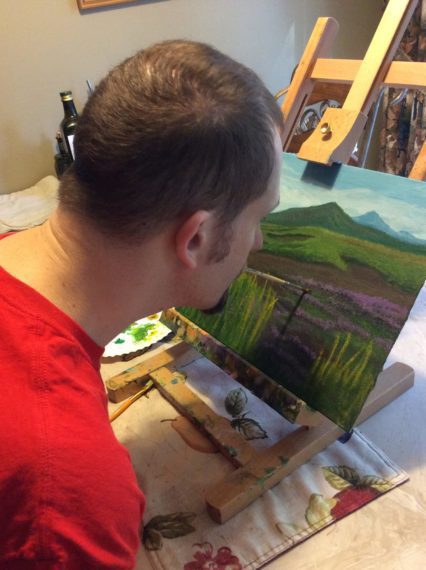Meet Alex Biaggi

“When you love something you do it until you can no longer do it.”
After enduring a young adulthood (1996 -2001) of spinal stenosis, back surgeries (including a laminectomy and spinal fusion), and multiple knee surgeries, alongside many painful periods of recovery, Alex Biagi was back in shape and back to his old normal – a life of basketball and regular high school activities.
“I did lots of physical therapy and I tried to get my knees back in shape. It was very difficult, but I was able to get to a point where I could get my first job and I was also able to play basketball again.” But as his challenging health issues continued, eventually his love of playing sports would transform into love of other passions such as art and music.
“So after high school (2000) I went to college to learn 3D animation, multimedia production and design. I also took several music production courses as well. I was really enjoying them so I decided to double major with music as my second major. I was really getting into producing electronic music and I started to invest in some music gear. I bought an expensive piano, computer, and a beginner digital music program. I was on my way! I figured since I wasn’t going to pursue sports this would be the next best thing and things were going great! And I was starting to feel really good!” Never did he imagine that his physical health would present challenges in these areas too.
Everything took a turn in 2004. Alex’s left hand started to hurt. At first, he was diagnosed with Carpal Tunnel Syndrome, and endured even more surgeries to resolve these painful injuries.
“In addition to carpal tunnel surgery on both hands, I also had ulnar nerve relocation surgery on both elbows.” But, on Thanksgiving eve in 2004, something occurred that was far from his carpal tunnel symptoms — Alex fell down his stairs.
“My ankle gave way,” Alex explained. “That’s when we knew something else was going on.” Alex lost use of his arms, hands and legs. From there forward, it took four years for doctors to diagnose Alex with Chronic Inflammatory Demyelinating Polyneuropathy (CIDP).
“It affects approximately one to two people in 100,000 per year,” said Alex’s doctor. “Alex has had a severe case of CIDP,” he said.
When Alex was first diagnosed, he gave up on art because his hands simply wouldn’t allow it. “But when you love something, you find a way.” Three years ago he saw someone on the internet painting with their mouth. “I never even thought about doing it that way,” he said. “I finally decided to give it a try.”
For the past three years, Alex has been practicing this unique craft and his paintings continue to get better and better. His latest piece of art is making the rounds on the internet. A picture of him touching up his painted portrait of superstar athlete LeBron James exploded on Reddit.
“A good friend of mine decided to post the picture and it went viral,” Alex explained.
Each piece of art takes time. Alex says it takes more than a month before there is a finished product. His work is more than just paint on a canvass, it’s a symbol to never giving up.
“You gotta keep pursuing what you love. Otherwise, you’ll let the disease win,” he said.
Alex has endured eight surgeries through all this. He also went to the Mayo Clinic in Rochester, Minnesota, and saw the head neurologist there for six years. His disease has tamed after going through a unique stem cell treatment.* Alex stated, “I was in a power chair for four years prior to the stem cell transplant, now I’m walking close to 2 miles without stopping, with braces. And I’m getting full motion back in my right arm I’m the first to participate in the study in Colorado for CIDP.”
Alex wants to thank his family who also acts as his caretakers. He also wants to thank his friends. “They have done so much for me.” You can find Alex’s art on his Instagram page @alexbiagi680.
*From the desk of Dr. Jeff Allen, GBS|CIDP Medical Advisory Board
“Although Stem Cell Transplant in CIDP may be helpful in some patients it is unproven and comes with significant risk. Patients need to find a neurologist that can educate them on proper escalation of immunotherapy proportional to the severity of their disease – which almost never means SCT.”

